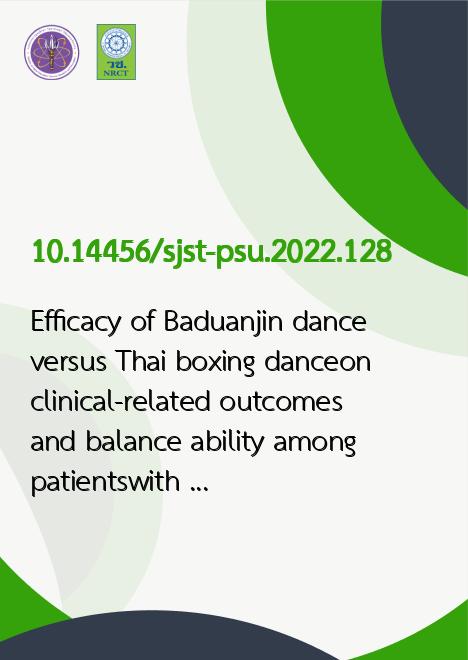
|
Efficacy of Baduanjin dance versus Thai boxing danceon clinical-related outcomes and balance ability among patientswith knee osteoarthritis: A randomized, single-blinded comparative trial |
|---|---|
| รหัสดีโอไอ | |
| Creator | 1. Titi Phanjaroen 2. Pattanasin Areeudomwong 3. Vitsarut Buttagat 4. Sinee Tantasatityanon |
| Title | Efficacy of Baduanjin dance versus Thai boxing danceon clinical-related outcomes and balance ability among patientswith knee osteoarthritis: A randomized, single-blinded comparative trial |
| Publisher | Research and Development Office, Prince of Songkla University |
| Publication Year | 2565 |
| Journal Title | Songklanakarin Journal of Science an Technology (SJST) |
| Journal Vol. | 44 |
| Journal No. | 4 |
| Page no. | 963-970 |
| Keyword | Baduanjin, balance, osteoarthritis, pain, Thai boxing |
| URL Website | https://rdo.psu.ac.th/sjst/index.php |
| ISSN | 0125-3395 |
| Abstract | This study aimed at comparing the effects of Baduanjin dance (BD) and Thai boxing dance (TBD) on clinical-relatedoutcomes in knee osteoarthritis (KOA) patients. Fifty-six KOA participants were assigned to receive a six-week intervention ineither BD or TBD group. Symptoms, balance ability, knee strength, and fear of movement were assessed before and after sixweeks, and at three-month follow-up. Both groups showed improvements in symptoms and static balance with eyes closed at twofollow-ups while better knee flexor and extensor strength were maintained in BD group. TBD increased dynamic balance andknee flexor and extensor strength at six weeks only. TBD showed greater improvements in symptoms, fear of movement andknee flexor strength at six weeks compared to BD; however, BD demonstrated a superior retention effect on knee flexor strengthcompared to TBD. In conclusion, BD and TBD improve symptoms, balance ability and knee strength, and could include them toclassical therapeutic interventions for KOA rehabilitative program. As BD maintains knee strength in a long-term period, thus itmight be a recommended complementary exercise for KOA patients in the communities. |
